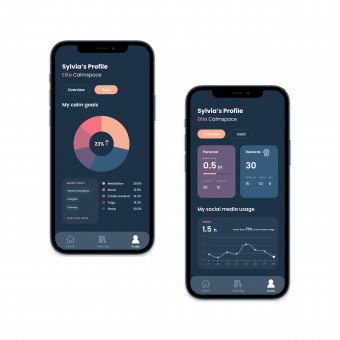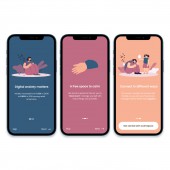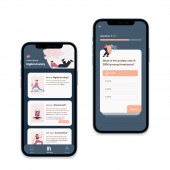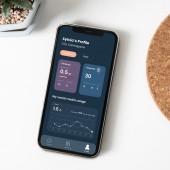
| THE AWARD |
| CATEGORIES |
| REGISTRATION |
| SUBMIT YOUR WORK |
| ENTRY INSTRUCTIONS |
| TERMS & CONDITIONS |
| PUBLICATIONS |
| DATES & FEES |
| METHODOLOGY |
| CONTACT |
| WINNERS |
| PRESS ROOM |
| GET INVOLVED |
| DESIGN PRIZE |
| DESIGN STORE |
| THE AWARD | JURY | CATEGORIES | REGISTRATION | PRESS | WINNERS | PUBLICATIONS | ENTRY INSTRUCTIONS |
Calmspace Healthcare Mobile App by Anqi Chen |
Home > Winners > Design #160334 >Interview |
 |
|
FS: What is the main principle, idea and inspiration behind your design?
AC: The concept of Calmspace was born out of my observation during the COVID-19 pandemic, where the prevalence of anxiety among young adults increased due to the constant digital connectivity and digital addiction enforced by remote work and learning. Recognizing this issue, I envisioned Calmspace as a mobile design solution tailored to alleviate technology-induced anxiety among young adults in educational and professional settings.
FS: What has been your main focus in designing this work? Especially what did you want to achieve?
AC: My design focus for Calmspace aims to bridge young adults’ dilemma between self-care and social connections, and break down the barriers of budget, location by making them at home. Calmspace aims to enhance happiness, and natural, proactive interaction for a healthier digital lifestyle.
FS: What are your future plans for this award winning design?
AC: Calmspace is a mobile design concept, and luckily after it received so many international achievements, I plan to work with a group of tech-driven cross-functional people to implement it.
FS: How long did it take you to design this particular concept?
AC: It took me around 3 days to research and interview targeted user people, and around 1 week to outline the primary skeleton of the design prototypes. In the meanwhile, I tested the design to evaluate its usability, and spent another two weeks polishing the visual system and finalizing the work.
FS: Why did you design this particular concept? Was this design commissioned or did you decide to pursuit an inspiration?
AC: As a mission-driven designer and problem-solver, I possess a keen awareness of the nuanced elements that prompt me to devise innovative design solutions. My decision to conceptualize Calmspace stemmed from a poignant observation: the pervasive prevalence of anxiety among young adults, exacerbated notably during the pandemic era. This period saw individuals like ourselves predominantly confined to home settings, balancing work, study, and social interactions virtually. Amid this landscape, anxiety emerged as a pressing concern demanding attention. Drawing inspiration from intimate conversations with friends and family, I was captivated by the profound dynamics of human connection, emotions, and the transformative potential of technology. Leveraging my expertise in UX Design and psychological practice, I resolved to embark on the creation of Calmspace, a venture aimed at fostering tranquility and well-being in our digitally interconnected world.
FS: Is your design being produced or used by another company, or do you plan to sell or lease the production rights or do you intent to produce your work yourself?
AC: So far Calmspace is a design concept and owned by me. I’m interested and excited to initiate this kind of conversation should any team want to partner to expand my work.
FS: What made you design this particular type of work?
AC: My curiosity about the world, coupled with a passion for exploring technology to fuel creativity, along with my sense of empathy and a desire to assist people through designs infused with narratives and functionality, have collectively shaped my journey as a UX Designer, or we say Product Designer. I realize that we are currently at a critical juncture where it's imperative to explore and implement innovative and efficient solutions to address challenges within the realm of human-computer interaction methods and tools.
FS: Where there any other designs and/or designers that helped the influence the design of your work?
AC: While Calmspace represents my independent design endeavor, I am deeply grateful for the generous support I've received from fellow designers, particularly during the peer review and usability testing stages. Their valuable feedback, encompassing aspects such as design value, rationale, and quality, has played a pivotal role in refining Calmspace into a truly exceptional project. Their contributions have propelled Calmspace to new heights, elevating it to a winning standard of excellence.
FS: Who is the target customer for his design?
AC: The targeted user group for Calmspace are young adults who are at school or working in professional industries and who have access to digital devices such as phones, tablets and laptops.
FS: What sets this design apart from other similar or resembling concepts?
AC: While many other similar wellness mobile apps adopt a subscription-based business model, Calmspace aims to eliminate the barrier for young adults who have budget limits, thus encouraging more people to access for free. In the meantime, Calmspace’s freemium model also includes features (sessions, activities) that require in-app credits to redeem, where people can purchase membership or engage in educational quizzes to acquire.
FS: How did you come up with the name for this design? What does it mean?
AC: Calmspace embodies a space characterized by serenity, tranquility, and security. My mission is to provide a nurturing digital environment where users can comprehend digital anxiety, engage seamlessly with our features, and derive genuine enjoyment. Through Calmspace, individuals can effectively destress, engage in self-care practices, and forge healthier connections with others.
FS: Which design tools did you use when you were working on this project?
AC: Brainstorm and ideation: paper, pen. High-fidelity design: software design tools such as Figma and Adobe Illustrator.
FS: What is the most unique aspect of your design?
AC: Calmspace has curated a color palette that resonates with Gen-Z sensibilities, aligning closely with the age group comprising its primary user base. To gain insight into the preferences and requirements of this demographic, I delved into socio-psychological methodologies, including positive reinforcement strategies. Furthermore, Calmspace is committed to removing barriers related to budget constraints and technological accessibility, prioritizing users' mental well-being. In pursuit of this goal, we're introducing a smart analysis dashboard feature, empowering users to assess their usage patterns and optimize their digital experiences proactively.
FS: Who did you collaborate with for this design? Did you work with people with technical / specialized skills?
AC: I was the sole designer for this design work, and this is my independent project.
FS: What is the role of technology in this particular design?
AC: Calmspace is a mobile design intended for iOS devices, and its goal is to propose a portable, engaging, user-friendly, and visually appealing user experience, while evoking its design innovation, creativity and empathy among the public community.
FS: Is your design influenced by data or analytical research in any way? What kind of research did you conduct for making this design?
AC: Yes. During the research phase, I focused on solving “How can we raise awareness of young adults' anxiety through digital tech, addressing their ‘always connected’ concerns for well-being”? I defined Calmspace's user group, analyzed market trends, and conducted secondary research on anxiety, particularly during the pandemic. Surveys, interviews, and the exploration of similar apps informed primary research, revealing insights: existing mental well-being apps focus on paid subscription for meditation, people seek disconnection from the virtual world while desiring in-person connections, and there is a need for motivation in addressing digital anxiety.
FS: What are some of the challenges you faced during the design/realization of your concept?
AC: The most challenging aspect of developing the Calmspace concept was delineating the user group while recognizing technical limitations. In the research phase, I assumed that the ideal users for Calmspace would be individuals aged 18 to 30, encompassing both students and industry professionals in sectors with ready access to digital technologies.
FS: How did you decide to submit your design to an international design competition?
AC: I realized that a good design needs the world's attention, and I was honored that Calmspace received the A’Design Award from A’Design Award & Competition. I’m excited and look forward to attending the award ceremony in Como, Italy this July when Calmspace can meet with other inspiring works and their creators.
FS: What did you learn or how did you improve yourself during the designing of this work?
AC: From my experience designing Calmspace, I have discovered strategies to reduce young adults' reliance on smartphones. Through rigorous user testing, I pinpointed areas for future enhancement and explored technological avenues beyond conventional phone usage. Embracing the principle of "Don't boil the ocean," I learned to focus on specific aspects of digital anxiety, strategically targeting user demographics during research phases to narrow down problem areas effectively. Early scoping ensures that we address pertinent issues efficiently. Additionally, involving users in the design process has proven invaluable, as their feedback contributes significantly to refining our design approaches.
FS: Any other things you would like to cover that have not been covered in these questions?
AC: N/A
FS: Thank you for providing us with this opportunity to interview you.
A' Design Award and Competitions grants rights to press members and bloggers to use parts of this interview. This interview is provided as it is; DesignPRWire and A' Design Award and Competitions cannot be held responsible for the answers given by participating designers.
| SOCIAL |
| + Add to Likes / Favorites | Send to My Email | Comment | View Press-Release |





